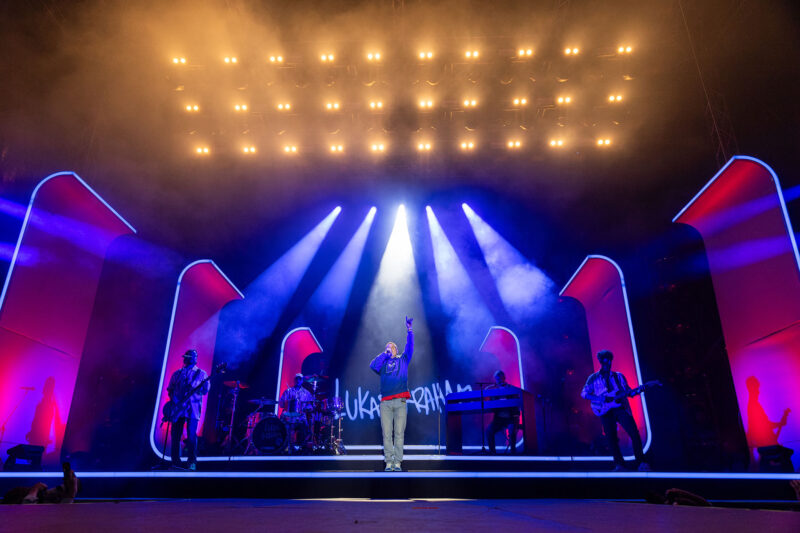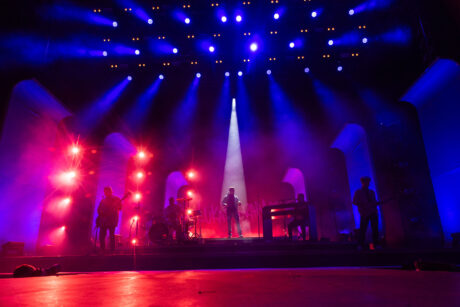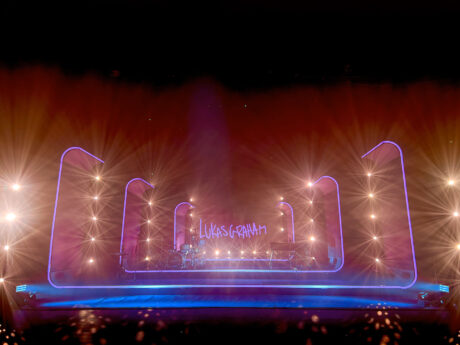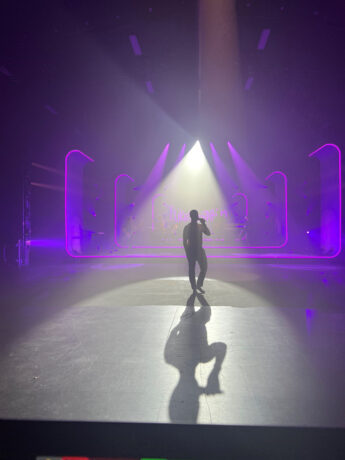
Danish Lighting Designer Johnny Thinggaard was asked to create a production design for popular Danish pop / soul artist Lukas Graham’s The Pink Tour, for which Johnny presented a clean, modern, and stylish environmental concept, with three striking perspective related scenic walls covered in fabric and with integral LED pixels along the tops, enhancing the depth and dimensions of the performance space.

Thinggaard’s original idea was based on his love of side angled photography and images that reveal details and spatial elements of the background. He also wanted something that was architecturally bold, but essentially simple in expression—with stunning results. For the first part of the tour, he used Robe T1 Profiles as front followspots, running on a Robe RoboSpot system.
When it came to the festival section of the ongoing tour, Thinggaard wanted to add some more upstage light sources to enhance the aesthetic, and he chose Robe FORTES for the job. Five fixtures are used in total, four standard FORTES primarily for the band, with a FORTE FollowSpot in the canter comprising the main back lighting on Lukas Graham himself, all controlled via a RoboSpot BaseStation located backstage.
It was Thinggaard’s original intention to use BMFL WashBeams for the back lighting, a fixture he loves for its power and quality of light, however rental company Vigsø Dryhire A/S had recently invested in FORTES—delivered by Robe’s Danish distributor Light Partner—so they suggested these which are currently Robe’s most powerful LED light source. Thinggaard is delighted with the choice.

He notes the intensity, precision and colors of the FORTE which are all “fantastic” and appreciates the optics and the resulting intensity and smoothness of the light beam, all of which “fitted perfectly into the visual style developed for this specific show design.” He also mentions how quick and easy they are to program and focus during the short festival changeovers.
Whilst not directly involved with the set-up and configuration of the RoboSpot system, its accuracy, and the creative possibilities it opens in terms of changing colors, effects, and timing make a huge difference to his ability to create the requisite moods and for synching effects with key moments in the music.
Colors and timing are both fundamental tools for Thinggaard  in interpreting the music with lighting, and moments of magic will often happen during long color fades. His Pink Tour color palette contains multiple pastels—delicate pinks, mysterious lavenders, and interesting and unusual ambers—with almost no primaries. It is strongly subtle, “If that makes sense?” he states, adding that the FORTES have been impressive in creating this collection of more off-beat hues and shades.
in interpreting the music with lighting, and moments of magic will often happen during long color fades. His Pink Tour color palette contains multiple pastels—delicate pinks, mysterious lavenders, and interesting and unusual ambers—with almost no primaries. It is strongly subtle, “If that makes sense?” he states, adding that the FORTES have been impressive in creating this collection of more off-beat hues and shades.
Also key to this intricate show is the scenography not diverting the audience’s attention from the artist or overwhelming the visual picture, rather supporting, and embracing each song. This relatively classical approach and the smart design has enabled musical accents and kicks to often be created via lighting interactions on the set walls.

The fully timecoded show is run from a grandMA3 console (running in 2 mode) with all the FORTE parameters for the four band spots controlled via the console, together with the colors and intensity for Lukas’s central spot.
Assisting Thinggaard with the programming is August Thede and the Touring Lighting Operator is Victoria Enoch. The Lighting Crew are Tobias Vohnsen, Rasmus Wiberg, Martin Jepsen, Niels Marcussen, and Mikkel Christensen.
Overseeing all things technical on the road is Production Manager Bent Lauridsen, the Tour Manager is Anders Nørgaard Nielsen, and the pre-production and advance is being coordinated by Jens Qvistgaard.
Further information from Robe lighting: www.robe.cz
Photos: Johnny Thinggaard / Allan Niss


